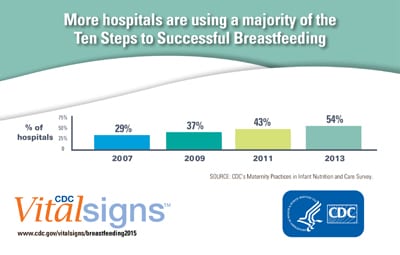 More hospitals are using a majority of the Ten Steps to Successful Breastfeeding Entire Infographic
More hospitals are using a majority of the Ten Steps to Successful Breastfeeding Entire Infographic
Atlanta, GA–(ENEWSPF)–October 6, 2015. Hospital support for breastfeeding has improved since 2007, according to the latest CDC Vital Signs report released today. The percentage of U.S. hospitals using a majority of the Ten Steps to Successful Breastfeeding, the global standard for hospital care to support breastfeeding, increased from approximately 29 percent in 2007 to 54 percent in 2013, a nearly two-fold increase over six years. Improved hospital care could increase rates of breastfeeding nationwide and contribute to healthier children.
“Breastfeeding has immense health benefits for babies and their mothers,” said CDC Director Tom Frieden, M.D., M.P.H. “More hospitals are better supporting new moms to breastfeed — every newborn should have the best possible start in life.”
Of the nearly four million babies born each year in the U.S., 14 percent are born in Baby-Friendly hospitals, a number that has nearly tripled in recent years, but remains low. The Baby-Friendly Hospital Initiative (BFHI) was established by the World Health Organization and UNICEF and endorsed by the American Academy of Pediatrics. The core of the BFHI is the Ten Steps to Successful Breastfeeding.
“What happens in the hospital can determine whether a mom starts and continues to breastfeed, and we know that many moms – 60 percent – stop breastfeeding earlier than they’d like,” said Cria Perrine, PhD, epidemiologist in CDC’s Division of Nutrition, Physical Activity and Obesity. “These improvements in hospital support for breastfeeding are promising, but we also want to see more hospitals fully supporting mothers who want to breastfeed. The Ten Steps help ensure that mothers get the best start with breastfeeding.”
Findings from CDC’s Maternity Practices in Infant Nutrition and Care Survey
This Vital Signs report examined data from CDC’s national survey, Maternity Practices in Infant Nutrition and Care (mPINC), which measures the percentage of U.S. hospitals with practices that are consistent with the Ten Steps to Successful Breastfeeding. The Ten Steps are measures of a hospital’s breastfeeding support before, during, and after a mother’s hospital stay. Some of the steps include:
Educate all pregnant women about the benefits and management of breastfeeding.
Help mothers initiate breastfeeding within one hour of birth.
Keep mothers and babies together throughout the entire hospital stay.
Provide mothers with information about breastfeeding support groups and refer mothers to these groups upon discharge from the hospital.
Other encouraging findings from the report include:
Across all survey years, hospital staff provided high levels of:
prenatal breastfeeding education (91 percent in 2007 and 93 percent in 2013) and
teaching mothers breastfeeding techniques (88 percent in 2007 and 92 percent in 2013).
Early initiation of breastfeeding increased from approximately 44 percent in 2007 to nearly 65 percent in 2013.
Other mPINC data show why continued improvement is needed:
In 2013, just 26 percent of hospitals ensured that only breast milk was given to healthy, breastfeeding infants who did not need infant formula for a medical reason.
In 2013, only 45 percent of hospitals kept mothers and babies together throughout the entire hospital stay, which provides opportunities to breastfeed and helps mothers learn feeding cues.
In 2013, only 32 percent of hospitals provided enough support for breastfeeding mothers when they left the hospital, including a follow-up visit and phone call, and referrals for additional support.
There are specific actions hospitals can take to better support mothers to breastfeed. These actions include:
Implement the Ten Steps to Successful Breastfeeding and work towards achieving Baby-Friendly status.
Use CDC’s Maternity Practices in Infant Nutrition and Care survey customized reports to improve maternity care practices that support breastfeeding.
Work with doctors, nurses, lactation care providers, and organizations to create networks that provide clinic-based, at-home, or community breastfeeding support for mothers.
Health Benefits of Breastfeeding
There are many health benefits to breastfeeding. Babies that are breastfed have reduced risks for ear, respiratory, stomach and intestinal infections. They also are at lower risk of asthma, obesity, and sudden infant death syndrome (SIDS). Pre-term infants are at a particularly high risk of necrotizing enterocolitis, a disease that affects the stomach and intestinal tract; breastfeeding can protect infants from this disease.
Also, mothers that breastfeed are less likely to get breast cancer, ovarian cancer, type 2 diabetes and heart disease.
Breastfeeding also saves money. More than $2 billion in yearly medical costs for children could be saved if breastfeeding recommendations were met.
For more information about CDC’s work to improve hospital practices to support breastfeeding, visit www.cdc.gov/breastfeeding. For more information about breastfeeding rates, state programs and other activities to support breastfeeding, please visit www.cdc.gov/breastfeeding/promotion.
Vital Signs is a CDC report that appears on the first Tuesday of the month as part of the CDC journal Morbidity and Mortality Weekly Report. The report provides the latest data and information on key health indicators. These are cancer prevention, obesity, tobacco use, motor vehicle passenger safety, prescription drug overdose, HIV/AIDS, alcohol use, health care-associated infections, cardiovascular health, teen pregnancy, food safety and viral hepatitis.
Source: www.cdc.gov








